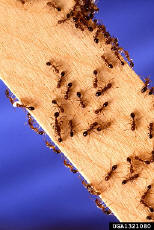
Red imported fire ants (
Solenopsis invicta
).
Photo: Scott Bauer, Bugwood.org |
Insects are the most numerous and speciose class of animals on the planet. They form the base of many food chains for higher animals. Many are small and not easily seen because they are good at hiding. This helps them escape detection when they are accidentally imported on other goods coming into this country.
Use the resources below to help guide you to information about invasive insects.
Visit our partner - Discover Life
Discover Life have developed include a list of Kinds of North American Invasives, a reporting system and database for the Hemlock Woolly Adelgid.
Distribution maps for five species of invasive ant (Yellow Crazy Ant, Argentine Ant, Tropical Fire Ant, Red Imported Fire Ant, Little Fire Ant, and other ant species).
 Pest Tracker - news, maps, factsheets, control efforts, publications and more!
Pest Tracker - news, maps, factsheets, control efforts, publications and more!
If you think you've found a new pest see our page on Reporting systems to let someone know!